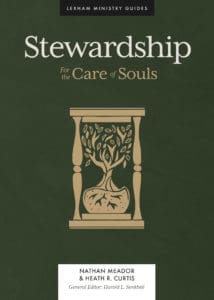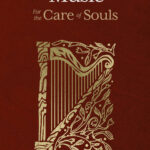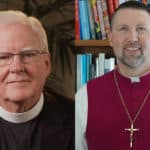
In this excerpt from Stewardship: For the Care of Souls, Nathan Meador and Heath Curtis present a practical theology of stewardship rooted in our shared identity as image bearers established in Genesis.
This is yet another book about stewardship; however, this is not just another book on stewardship. Most books on stewardship focus on money management, the offering plate, and perhaps creation care. More rarely, works focus on the theology of stewardship. This stewardship book will be different.
It is not a book about the mechanics of stewardship from a programmatic approach. You will not discover in this work a tried-and-true, sure-fire method that will fill the coffers to overflowing so that the local congregation and the church at large can do whatever they desire in ministry. Neither will the book simply give a paint-by-number plan to ensure the institutional survival of a congregation that has ministered for generations without ever adapting their approach to the world in which they have been placed for the service of the gospel.
What you will get in this book is a fresh focus on stewardship, with the ultimate aim being the care of souls.
This book focuses on individual stewards, their orientation toward God as stewards of creation made in the image of God (Gen 1:26–28), and their re-created image-bearing as stewards of the gospel of Jesus Christ, who endured the cross and grave to make his stewards new in time and in eternity.
This book will point pastors and steward leaders to the critical roles of preaching, teaching, and the pastoral care of stewards with the clear realization that poor stewardship is a matter not only of being stingy and miserly but also, in essence, of idolatry. The stewardship sin of idolatry, flowing from the first stewardship crisis of our first parents in the garden (Gen 3), highlights the need for the task of pastoral and lay leaders to preach and teach stewardship as a call to repentance and new life.
This book will present a practical theology of stewardship that calls both individual stewards and the congregation as corporate stewards to embrace and live in their identity as stewards who have been baptized into Christ.
The Why of Stewardship
For the last three decades, my denomination has defined stewardship this way: “Christian stewardship is the free and joyous activity of the child of God and God’s family, the church, in managing all of life and life’s resources for God’s purposes.” It has served our church well. Yet this definition makes an often-committed mistake in teaching stewardship. It focuses on the what and how of stewardship, without capturing the why.
When we become fixated on stewardship’s what and how, we are starting in the wrong place. When a pastor teaches tithing and offerings, percentage giving, sacrificial service, and many other concepts of the what and how of stewardship, without providing the stewards with a clear view of the why, the stewards end up lost. St. Paul talks to the Corinthians about how much God loves a cheerful giver, but without knowing the why of stewardship, cheerfulness is not possible. People may faithfully give and serve, but what they have lost is the freedom and joy of knowing why they are stewards in the first place.
To capture the why of stewardship, stewards must be taught their identity before they are taught their activity. To find this identity, look no further than Genesis 1:26–28.
Then God said, “Let us make man in our image, after our likeness. And let them have dominion over the fish of the sea and over the birds of the heavens and over the livestock and over all the earth and over every creeping thing that creeps on the earth.” So God created man in his own image, in the image of God he created him; male and female he created them. And God blessed them. And God said to them, “Be fruitful and multiply and fill the earth and subdue it, and have dominion over the fish of the sea and over the birds of the heavens and over every living thing that moves on the earth.”
—Genesis 1:26–28
Our identity as stewards is rooted in the Lord’s created order. The modern church very often defines the vocation of steward by its activity. Our sinful human nature hears instructions like “have dominion” and “subdue” and receives them with great glee. Who would not want to have dominion over all creation? In the fallen mind, it is good to be king. When people think they are kings, calling the shots is seen as a benefit.
Here again it is necessary to start at the right place: with the creation of the stewards in the “image of God.” The Hebrew word used here, which occurs only four times in the Hebrew Scriptures, all of which are in Genesis, connotes an image or reflection of the original. This means that the activity of stewards, subduing and having dominion, is modified by the identity for which stewards have been created. Stewards are to carry out the stewardship of subduing and having dominion as a reflection of the Creator. Stewards are not tyrants to domineer over creation or to beat it into submission to their will. Stewards are to reflect the will and heart of the Owner of all things, who by virtue of creation is God. So all of creation, including humans as its stewards, is to be an extension of the heart of the Creator. Within this image, the holy and just steward is to do exactly what the Lord created him to do: steward creation.
This identity is then further clarified in the next chapter of Genesis. Here, stewards are given a very clear purpose: “The LORD God took the man and put him in the garden of Eden to work it and keep it” (Gen 2:15). The man was created for the task of work. Work is regarded as an essential part of the human existence. Human beings cannot have meaning or fulfillment without this obligation. The labor that is stewardship was a joyful labor. At this point, stewardship was not a chore or a bore. It was exactly what humanity was created for.
Stewardship is a priestly task. The Hebrew in this passage makes this clear. While the words for work (avad) and keep (shamar) are common in the Old Testament, they both have priestly overtones. Avad describes the priests’ work in the temple; shamar describes the priests’ task of defending the temple. Work and worship go together. St. Paul echoes this in Romans 12. Human work is human worship of God. In our working and keeping of creation, we do what the Lord has given us to do.
This is the why of stewardship. God has made us for this purpose! There was only one vocation in the garden: that of steward. Like a hammer was created to drive a nail, people were created by God to serve as stewards. The purpose of stewardship does not begin with us. It begins in the creative power of God. He is the one who conceived this role. It is not an act of volunteerism or generosity. When stewards manage all of life and life’s resources for God’s purposes, they are simply doing what they have been given to do. Only when there is synchronicity between identity and activity, purpose is realized, and joy ensues. We will never find this if we start our stewardship journey from the point of what stewards do. When we embrace our identity as stewards, reflecting God’s image by the way we manage creation for God’s glory and the benefit of our neighbor, we are starting with our why. This aligns God’s word and our purpose and allows for the golden circle of stewardship to radiate from God, through us, to others. Stewards were made for this!
This post is adapted from Stewardship: For the Care of Souls by Nathan Meador and Heath R. Curtis (Lexham Press, 2021).







